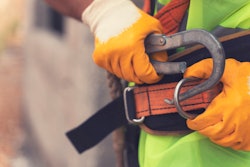
Coffee-stained, crumpled safety reports written in illegible handwriting can be found on jobsites across the country. And if they make the journey back to the office, they are strewn about a manager's desk or stuffed in a filing cabinet, never to be seen again. This process has become so commonplace many don’t stop to ask if there’s a better way.
Of course, construction professionals know safety is important. Nevertheless, they often dread safety processes; safety reports are no exception. To many, they’re tedious paperwork. However, they fit into the larger picture of risk management planning, which is critical for any construction company.
Safety Report Basics
Safety managers should regularly conduct inspections and file safety reports to ensure compliance and protect workers. At a minimum, they should do these:
- Directly after a workplace incident. In addition to the incident report, this will help companies get to the bottom of what went wrong
- At the outset of a new project. This will help identify hazards unique to the project
- Once a quarter. Having a regular rhythm of safety inspections can help mitigate risk and decrease liability.
Construction is already a dangerous job by nature, but failing to complete and incorporate the findings from safety reports only increases the danger, both physically for workers and financially for companies by increasing liability. Because of this, forward-thinking companies are digitizing their safety report processes. In doing so, they’re reducing the time it takes to file reports while increasing the utility of the reports.
Why Digital Safety Reports are the Future
The last decade has seen an explosion of technological innovation, yet many safety processes have gone unchanged. Too often, the motto in construction has been, “if it’s not broken, don’t fix it,” rather than, “don’t settle for second best.” Digital safety reports help companies capture more safety data, analyze it better, and implement changes more quickly. Yes, pen and paper have worked for thousands of years, and Excel has been going strong since 1985, but the horse and buggy worked for a time, too. With employee safety on the line, second-rate safety processes don’t cut it.
Adopting innovative safety report processes have an added benefit: employee recruitment. As the construction industry faces a labor shortage and struggles to attract younger employees, digitizing safety reports is a step in the right direction. The next generation of construction workers is a diverse group of digital natives. Traditional safety reports epitomize the aspects of construction work that keep future workers away. If done poorly, traditional safety reports reinforce the idea that construction is dangerous; if done manually, these reports lead construction to come across as outdated in a digital world.
Benefits of Digital Safety Reports
The time is ripe for changing safety report processes. For decades, people have seen construction injuries as inevitable. But they don’t have to be. Safety reports of any type help, but digital safety reports go one step further. With the right system in place, digital safety reports transform what was once marks on a piece of paper into valuable data. As companies fill out digital safety reports, they can track, report, and analyze safety issues to monitor safety performance over time, identify trends, and stop injuries before they happen.
Digital safety reports also benefit the bottom line. The construction industry abounds with safety regulations, and liability and compliance concerns come with these regulations. When a workplace injury occurs, a company must show that it has done its due diligence to create a safe work environment. Failing to do so places the company at risk of lawsuits and fines from the Occupational Health and Safety Administration (OSHA). With digital safety reports, companies can quickly access their reports and show the steps they’ve taken to ensure safety to the best of their ability.
Transitioning to Digital Safety Reports
The first step in digitizing construction safety reports is developing a system for collecting and storing data. This typically involves selecting a software platform or system teams can use to fill out and store reports. In most cases, ease of use should be a top feature to look for in a platform for safety reports. You shouldn’t need an IT degree to complete a basic safety report. And with the right solution, everyone from 16-year-old summer workers to 60-year-old veterans can quickly adapt to digital safety reports.
Furthermore, ease of use should extend beyond completing the report to accessing and analyzing data from the reports. With cloud-based solutions, everyone from general contractors on site to executives in the boardroom can instantly access reports at the click or tap of a button.
Once a system is selected, the next step is to develop a process for collecting and reporting safety data. This typically involves developing a template or form that teams can use to collect data, such as the date of the incident, location, description of the incident, and any corrective actions taken. The template must include all the information necessary to ensure compliance and minimize liability down the road.
The final step is to develop a system for analyzing and monitoring safety performance. This typically involves setting up automated reports that can be used to identify patterns and trends in safety performance. This is especially beneficial for large-scale construction projects, as it can help to quickly identify potential risks and take appropriate action to address them.
No-code Platforms are Perfect for Digital Safety Reports
No-code platforms are quickly becoming the go-to option for digitizing safety reports. These platforms allow construction teams to benefit from advanced automation without needing a technical background. Using a no-code platform to create a customized safety report is as simple as dragging and dropping workflow blocks on a screen and selecting options from drop-down menus.
More specifically, construction companies are prioritizing no-code platforms tailor-made for the industry. These have built-in templates to cover a wide variety of scenarios, as well as automated compliance checkers. Because they’re made with construction in mind, these no-code platforms have a faster learning curve, allowing employees to spend less time learning the platform and more time focused on increasing safety.
Digital Safety Reports in Action
A leading mid-Atlantic construction company conducted 2,200 safety inspections per year. Each inspection required at least four pieces of paper which employees had to scan and email to various stakeholders in the company. Once received, corporate employees had to enter the information into a database manually. The process wasted time and frustrated employees.
Then, the company turned to a no-code business process automation platform designed for risk management processes. They eliminated 20 minutes per inspection and saved 10,000 pieces of paper annually. As soon as employees on the job site filled out a report, it was available to corporate employees on the cloud. With centralized data, they gained deeper insights into safety data to help prevent injuries. Furthermore, they received real-time compliance alerts to proactively ensure compliance and reduce liability.
Creating a Safer Future for Construction
In 2020, the construction industry experienced more preventable fatal injuries than any other industry. Safety reports, when taken seriously, can be a crucial part of changing this. But manual processes stand in the way. Digitization is the way forward.
When construction managers fill out safety reports by hand, they’re more likely to make errors, not provide all the necessary information for compliance, or simply misplace the document. By digitizing safety reports, construction managers can quickly fill out standardized reports on mobile devices. Furthermore, with cloud-based software, managers can store all files in a centralized location, making accessing the documents and implementing necessary changes easier. And in the end, this means safer work environments for today, and tomorrow’s, construction professionals.




















